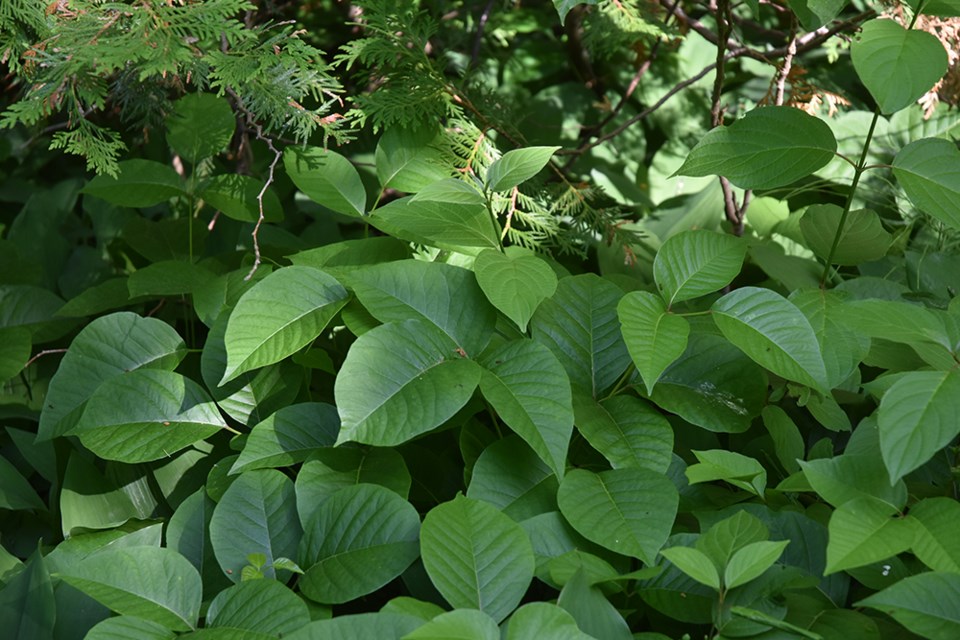‘Leaves of three, let it be.’
One of the hazards of strolling through Ontario’s woodlands is the likelihood of coming across Toxicodendron radicans – better known as Poison Ivy.
Poison ivy can grow as a ground cover, low shrub or a vine. Each leaf has 3 leaflets, attached to a long petiole The leaflets can be shiny or dull, depending on time of year and the location, and the edges of each leaflet can be smooth, toothed, or even deeply lobed. Leaves turn red, yellow or brown in fall; the berries are a waxy white or grey.
There are look-alikes in the forest, that are harmless. Virginia creeper, for example, is often mistaken for poison ivy - but it has five leaflets, not three. And Box Elder can look similar early in the season, but its leaves are opposite, growing facing each other, while the leaves of poison ivy are "alternate," alternating along the stem.
The very name 'Toxicodendron' indicates the danger: it comes from the Greek words for "poison" and "tree." Roots, stem, leaves, berries – all parts of this perennial vine-y plant contain urushiol, a highly persistent oil that causes contact dermatitis in 75 to 85 percent of people unfortunate enough to brush against it.
Reactions can range from mild itchiness to severe blistering, and can last for weeks.
Poison ivy is native to Ontario, and many local birds feed on the waxy berries. Bluebirds, thrushes, woodpeckers, waxwings and robins find the berries a good source of fat, when building up reserves for the winter.
Despite its value to wildlife, the plant is designated a Noxious Weed under the Ontario Weed Control Act, because of the threat to humans.
OMAFRA directs municipal councils, road authorities, operators of parks and conservation areas and even the general public to control poison ivy “wherever feasible.”
The Lake Simcoe Region Conservation Authority manages extensive acreage of conservation and forested lands, where poison ivy is rife – and in many areas, the plant is so pervasive that there is no reasonable way to control it, says Phil Davies, manager of forestry and green space services with the LSRCA.
“It is a native species, so we don’t control it in most cases,” Davies explains. “We identify areas where patches might pose a risk to staff and visitors” – such as gateways, gathering places, and locations where school groups regularly visit - “and then we spray.”
He notes that there is an added benefit to letting poison ivy remain along the edges of trails: it encourages people to stay on the pathways.
The LSRCA will post signage and “imagery” in areas where there are specific safety concerns, to educate the public and ensure visitors can recognize the plant, but there is no “Poison Ivy Policy” or consistent signage from location to location, he notes.
Poison ivy is also found in Innisfil parks, like Innisfil Beach Park – where it grows in wooded areas, along the edges of open fields and trails.
“When it comes to poison ivy we depend on our residents to let us know when they spot an area of concern,” says Johnny Keogh, communications lead for the Town of Innisfil. “Our staff will then investigate and if need be we can perform the application of an herbicide. When a decision is made to proceed with spraying, we hire a licensed applicator who posts all the necessary signage to advise residents.”
Herbicides containing glyphosate (like Roundup) and 2,4D with mecoprop or dicamba are part of the arsenal used to battle poison ivy, along with physical removal, involving digging and rooting up of the plants.
Care must be taken to avoid contact – long sleeves, long pants, and gloves are recommended - and poison ivy should never be burned: the urushiol forms a vapour that can be inhaled, causing internal blistering.
The oil is so persistent, that it can last up to 5 years in soils and on surfaces. Pets running through the undergrowth have been known to pick up the oil on their fur, transferring it to their owners when patted.
Come in contact with Poison Ivy? Experts recommend sluicing the area of contact with lukewarm soapy water immediately, to wash off as much of the oil as possible – although one website suggests that the urushiol binds “irreversibly” to skin cells.
Treatments for the intense itching and blistering include peppermint, Tea Tree oil, topical creams and corticosteroids. Victims should see a dermatologist.
But the number one recommendation? ‘Leaves of three, let it be.’



